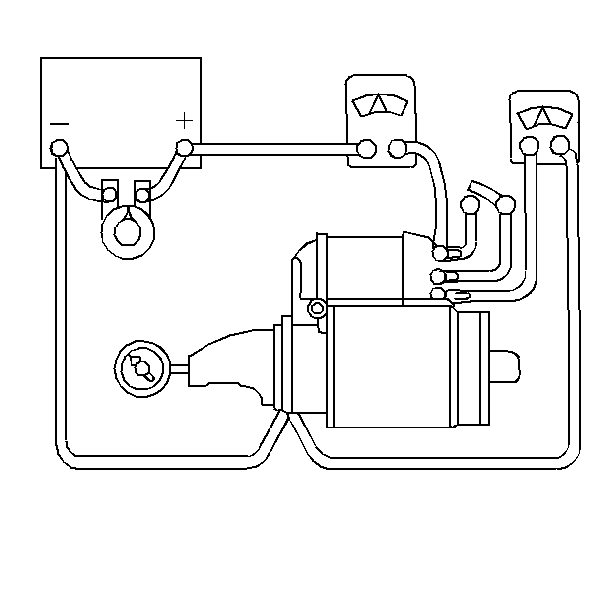Tools Required
J 39200 Digital Multimeter
Before disassembling the starter motor for repair, do the following
test:

- Connect a voltmeter J 39200
from the starter motor terminal to the starter motor frame
(Ground), as shown.
- Connect the starter motor and an ammeter in series, from the positive
terminal of a fully charged 12 V battery.
- Connect a switch, in the Open position, from the S terminal of
the starter solenoid to the starter motor terminal.
Notice: Never operate the starter motor for more than 30 seconds at a time.
Allow it to cool for at least two minutes. Overheating, caused by too much
cranking, will damage the starter motor.
- Also, hold an RPM indicator to the end of the armature shaft, in order
to measure the speed.
- Close the switch.
- Compare the following measurements with the specifications.
| • | The RPM (armature speed) |
| • | The current draw (Amps) |
- It is not necessary to obtain the exact voltage as specified.
- If the voltage is slightly higher, the RPM will be slightly higher,
and the current (amps) will remain unchanged.
- If the exact voltage is desired, connect a carbon pile across
the battery to reduce the voltage to the specified value.
The test results indicate the following conditions:
| • | Rated current draw (amps), and rated no-load speed (RPM). |
| | This indicates the normal condition of the starter motor. |
| • | Low, no load speed (RPM) and high current draw (amps). |
| - | This could indicate too much friction, causing the armature to
drag. |
| - | This can result from any of the following conditions: |
| • | Tight, dirty, or worn bearings |
| - | These conditions can be checked further on a growler, after disassembly. |
| • | Failure to operate (no RPM), with high current draw (amps), indicates
the following possible conditions: |
| - | A direct short to ground in the starter terminal or in the fields. |
| - | Seized bearings (This should have been noted by turning the armature
by hand). |
| • | Failure to operate (RPM), with no current draw (amps), indicates
the following conditions: |
| - | An open field circuit. This can be checked after disassembly by
inspecting the internal connections and by tracing the circuit with a J 34142-B
. |
| - | An open circuit in the armature coils. |
| - | Inspect the commutator for badly burned bars, after disassembly. |
| - | Broken or weak brush springs |
| - | High insulation between the commutator bars. |
| - | Other causes which would prevent full contact between the brushes
and the commutator |
| • | Low, no load speed (RPM) and low current draw (amps), indicates
a high internal resistance caused by the following conditions: |
| - | Poor electrical connections |
| - | Defective electrical leads |
| - | Other causes listed under test result number 4 (above). |
| • | High, no load speed (RPM) and high current draw (amps) indicating
shorted fields. |
| | Install a new field coil assembly, then check for improved performance. |

